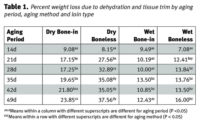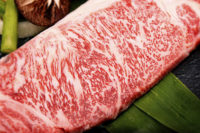 Tenderness, juiciness and flavor are commonly known as the main attributes that describe beef palatability, with tenderness being most important to consumers. The beef industry has heavily marketed the rib and loin, which meet consumer demand for a tender, flavorful and juicy product. Tougher cuts from the chuck and round are typically marketed as lower-valued roasts, steaks and ground beef. Consumers are looking for affordable, convenient cuts without sacrificing favorable palatability attributes. The beef industry has an opportunity to capture underutilized value of end cuts by appealing to consumers’ product demands.
Tenderness, juiciness and flavor are commonly known as the main attributes that describe beef palatability, with tenderness being most important to consumers. The beef industry has heavily marketed the rib and loin, which meet consumer demand for a tender, flavorful and juicy product. Tougher cuts from the chuck and round are typically marketed as lower-valued roasts, steaks and ground beef. Consumers are looking for affordable, convenient cuts without sacrificing favorable palatability attributes. The beef industry has an opportunity to capture underutilized value of end cuts by appealing to consumers’ product demands.
In the late 1990s, The Beef Checkoff funded a Muscle Profiling Study. This study evaluated individual muscles from the chuck and round. The second-most tender muscle (infraspinatus), commonly called the Flat Iron, was the first successful value-added cut from this study. Results from this study have led to the success of new beef cuts being introduced into the market over the past 10 years, including the Delmonico (chuck eye steak) and Denver (serratus ventralis).
Value cuts will only be successful in the market if consumers are educated and have the opportunity to compare them with more common retail cuts. Researchers at North Dakota State University conducted a study that consisted of educating consumers about value-added cuts and consumer assessment of palatability attributes of three traditional retail cuts (bottom round, ribeye and top sirloin) and a value cut (Delmonico or Denver) (Lepper-Blilie et al., 2014).
Three hundred and twenty-two people at four locations in North Dakota participated in the beef value cut education seminar series. The program provided new information that the consumer could relate to the samples provided at the end of the program. Participants evaluated tenderness, juiciness, flavor and overall liking of four samples: bottom round, top sirloin, ribeye and a value cut.
The ribeye and value cut were found to be similar for all four palatability attributes and both differed from the bottom round and sirloin (P < 0.05). The bottom round received the lowest scores for overall liking and tenderness, but did not differ from the top sirloin for juiciness and flavor. Correlations and regression analysis found flavor was the largest influencing factor for overall liking for the ribeye, value cut and top sirloin. The bottom round overall like score was influenced by tenderness and flavor.
In summary, the value cut in this study could potentially replace the ribeye steak when offered at a lower cost. The results from this study could be used to positively market lower-valued cuts obtained from the beef chuck. Educating consumers and allowing them to sample value cuts compared with traditional cuts will likely influence their future purchasing decisions.
Lepper-Blilie, A.N., E.P. Berg, A.J. Germolus, D.S. Buchanan, & P.T. Berg. (2014). Consumer evaluation of palatability characteristics of a beef value-added cut compared to common retail cuts. Meat Science, 96, 419-422.







